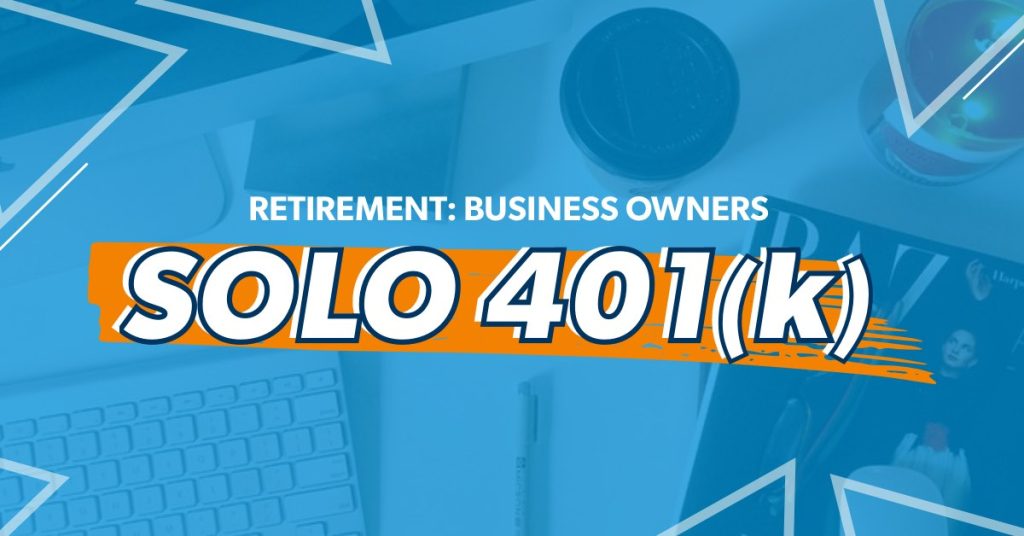You’re living the dream of working for yourself—hats off to you! There are so many benefits of having your own business. You get to set your own schedule, you get to set the rules . . . after all, you’re the boss!
On the other hand, there are some downsides—like not having access to an employer-backed retirement plan such as a 401(k). And since the most popular investing vehicle for becoming an everyday millionaire is—you guessed it—the 401(k), that probably has you wondering what is available to you. As a business owner, you know the importance of planning ahead.
That just means it’s up to you to make sure you’re taking steps to secure your retirement future, because no one else is going to do it for you! So, where does that leave you? Hang tight—the good news is that you do have options when it comes to planning for your retirement as a self-employed go-getter. Let me introduce you to one of those options: the solo 401(k).
What Is a Solo 401(k)?
Don’t worry, this isn’t a trick question. A solo 401(k) is an individual—hence the word solo—401(k) created for business owners that do not have employees. And that’s a key distinction.
You’ve got a couple options when it comes to choosing the solo 401(k) that’s right for you.
- Traditional 401(k): Contributions are made pretax—this reduces your taxable income for the current tax year. But you’ll have to pay taxes on any money you take out of the account in retirement.
- Roth 401(k): Contributions are made with after-tax dollars—this doesn’t reduce your taxable income for the current tax year, but you’re able to enjoy tax-free growth and tax-free withdrawals in retirement. Now that’s a win-win! If you have a chance to go with a Roth option, take it.
You probably know that a lot of companies that do have employees offer 401(k) plans like this that allow them to build their retirement nest eggs directly from their paychecks. Some companies will also match their employees’ contributions.
Now, with a solo 401(k), you—as the business owner—can make contributions both as an employee and as an employer. This allows you to maximize your contributions to your retirement account and also make deductions on your tax return.
Who Is Eligible for a Solo 401(k)?
While there are no age or income restrictions to participate in a solo 401(k), the main qualifier is that you must be a business owner with no employees. Uncle Sam is pretty strict on this. You can’t have any employees if you want to be eligible for the solo 401(k).
There is one exception: If you’re married and your spouse also works in the business, there’s a provision that allows your spouse to also receive contributions from the business at the same percentage. We’ll dive more into that in a minute.
More on that later!
What Are the Tax Benefits of a Solo 401(k)?
Listen, just because you’re not at a big company with a fancy retirement plan doesn’t mean you can’t save for retirement. In fact, there are several perks to going the solo 401(k) route! One great thing is that there’s flexibility with when you choose to pay taxes on your contributions. With a solo 401(k) all of the contributions you make as the employer are tax deductible for your business.
And for contributions you make as an employee in your business, it can go one of two ways. If you go with the traditional solo 401(k), these contributions reduce your personal taxable income for the current tax year and grow tax-free until you start taking distributions at retirement age—then the distributions will be taxed as regular income.
How much will you need for retirement? Find out with this free tool!
The other option is the Roth solo 401(k). While there’s no upfront tax break, it does allow you to enjoy your distributions tax-free. Again, if you’ve got the option, a Roth solo 401(k) is the way to go!
Just remember that if you decide to tap into your account before retirement age—regardless of whether it’s Roth or traditional—you’ll have to pay any penalties and taxes for doing so before age 59 1/2. Don’t do it!
How Much Can I Contribute to a Solo 401(k)?
Think of it this way—when it comes to your business, you’re essentially two people: the employer and the employee. That means you’re able to contribute to your retirement plan in two different ways.
There’s a total $69,000 contribution cap for 2024, with limits also applying to each role you play.1
You—the employee—can contribute up to $23,000 in 2024. On top of that, if you’re 50 or older you can take advantage of an additional $7,500 catch-up contribution.2 Yeah, baby!
You—the employer—have the option to contribute an additional profit-sharing contribution up to 25% of what you’re compensated (or your net self-employment income) up to that $69,000 cap for 2024. And just to keep it interesting, the IRS added one more rule: When you calculate your contribution percentage, the max amount of compensation you can use is $345,000 for the 2024 tax year.3
For example, let’s say you’re a 52-year-old business owner and you earn $65,000 in 2024. You contribute the $23,000 “employee” maximum for the year plus the $7,500 in catch-up contributions to your solo 401(k) plan. As the employer, you also contribute 25% of your compensation, which comes out to be $16,250 ($65,000 x 25%). The total contributions you’ll make to the plan for 2024 are $46,750 ($16,250 + $23,000 + $7,500). This is the most you can contribute to your plan for 2024.
Now, if your business is a side hustle and you still work for a company, keep in mind that your employee 401(k) limit applies to you as a person, not to each plan. That means if you’re also participating in a 401(k) at your regular job, the limit applies to contributions across all retirement plans that you’re contributing to—so $69,000 is still your cap.
Can a Solo 401(k) Cover a Spouse?
Yes! The IRS allows one exception to the no-employees rule on the solo 401(k). Your spouse is eligible to contribute to the same plan if he or she earns income from your business.
This is great news because you have the potential to double what you’re saving. Your spouse can contribute to the plan up to the $23,000 employee contribution limit, and—if they’re in the 50 and older category—they can add in the catch-up amount.
As the employer, you can then add the additional profit-sharing contribution for your spouse—up to 25% of compensation.
Are There Any Alternatives to the Solo 401(k)?
The solo 401(k) isn’t your only option. There are a few other retirement plans out there that may work better for you. You also have some options in addition to your solo 401(k) to help you save even more for retirement. The bottom line? You’ve got choices, people!
The other retirement plan options for business owners include:
Simplified Employee Pension Plan (SEP)
A SEP plan allows you—the employer—to contribute to traditional IRAs (SEP-IRAs) that are set up for your employees. It doesn’t matter how many employees you have (or don’t have) to be eligible to set up a SEP.4
There’s one big difference between SEP IRAs and other retirement plans—only the employer contributes to the plan. So, if you’re an employee and your employer offers this—we’re talking free money! SEP IRAs come with some advantages like easy setup, higher annual contribution limits, and contributions that are immediately vested—meaning it’s your money from day one.
Traditional Individual Retirement Accounts (IRA)
With a traditional IRA, you’re able to save for retirement with some pretty sweet tax advantages. The contributions you make to a traditional IRA have the potential to be fully or partially tax deductible. Plus, these contributions aren’t typically taxed until you start taking out distributions at retirement age.5
Roth IRA
It’s no secret—we love the Roth IRA! It’s an IRA that has a few different rules than the traditional IRA.
- Contributions to a Roth IRA are not tax deductible
- If you meet certain requirements, some distributions are tax-free
- You’re still able to contribute to your Roth IRA after you hit 70 1/2
- As long as you’re alive, you can leave your money in the Roth IRA6
Also, keep in mind—for the 2024 tax year—your total contributions to all of your traditional and Roth IRAs can’t exceed either of the following:
- Either $7,000 ($8,000 if you’re 50 or older), or
- Your taxable income for the year (if it was less than the limit)7
Of course, this list doesn’t cover everything. There may be other types of retirement plans that work better for you. Either way, we would strongly encourage you to connect with an investment professional to help walk you through your options.
How Do I Open a Solo 401(k)?
Got an employer identification number? Good, because that’s all you need in order to open a solo 401(k). Typically, these are set up with an investment broker. They’ll provide you with a plan adoption agreement and an account application to complete. After that you can set up your contributions.
If you plan to make contributions this year, make sure your plan is set up and ready to go by December 31 and make your employee contribution by the end of the calendar year. If you want to make your employer contributions, you can typically do so until the tax-filing deadline for the tax year.
Find a SmartVestor Pro!
As a business owner, you’re no stranger to getting scrappy and figuring things out on your own. But when it comes to something as important as investing, don’t go it alone. We encourage you to reach out to an investment professional who can help you with your financial goals.
Find a SmartVestor Pro in your area!
Read the full article here












